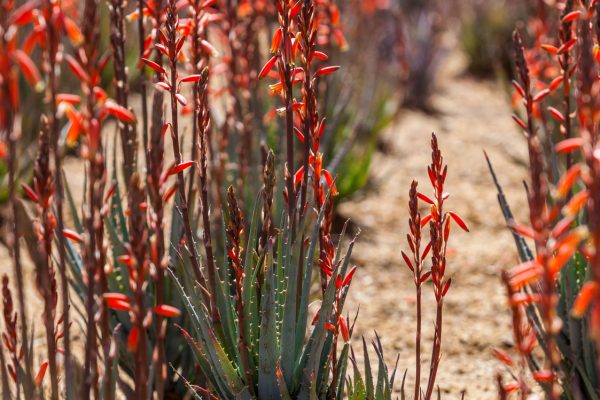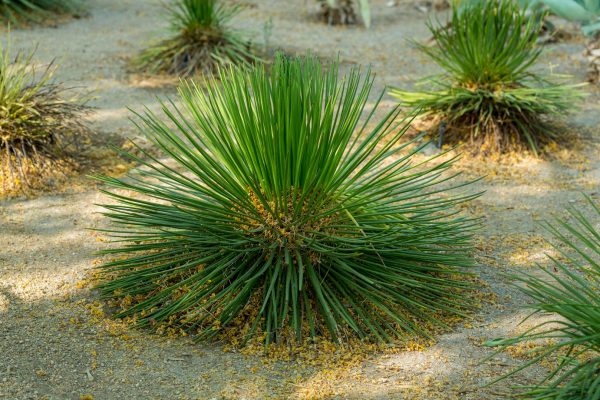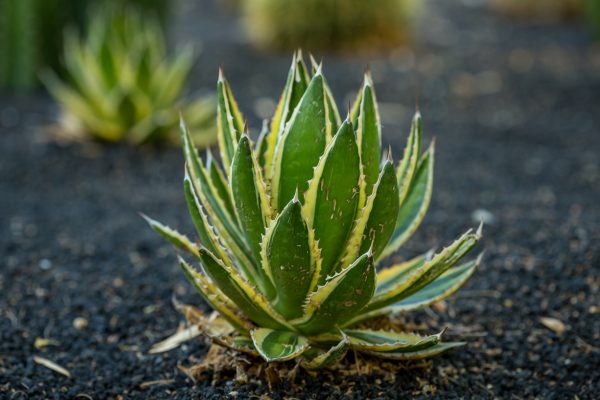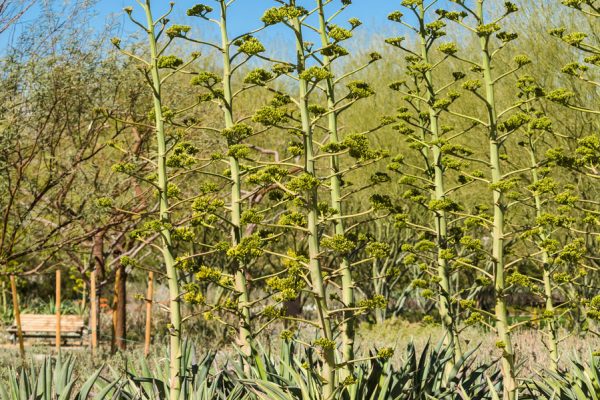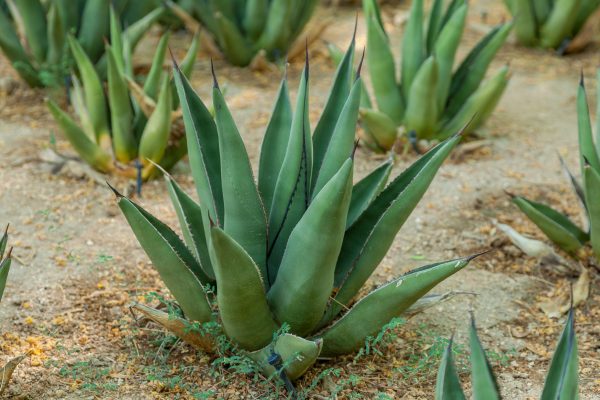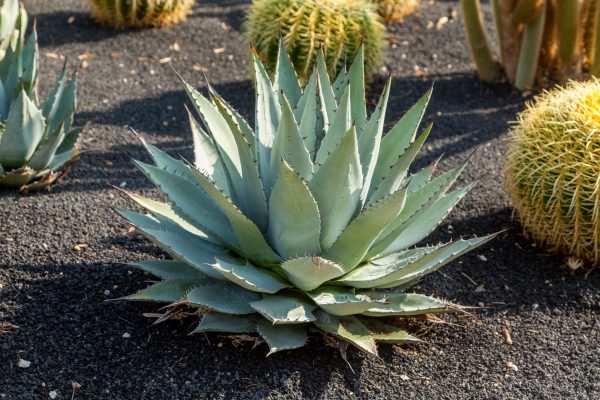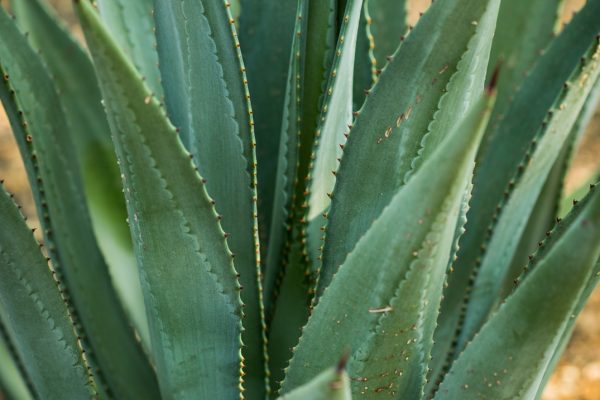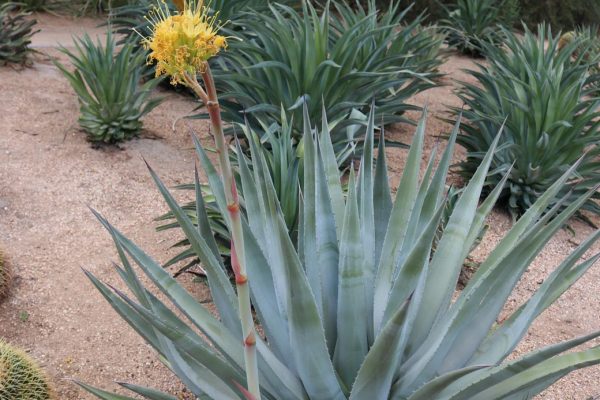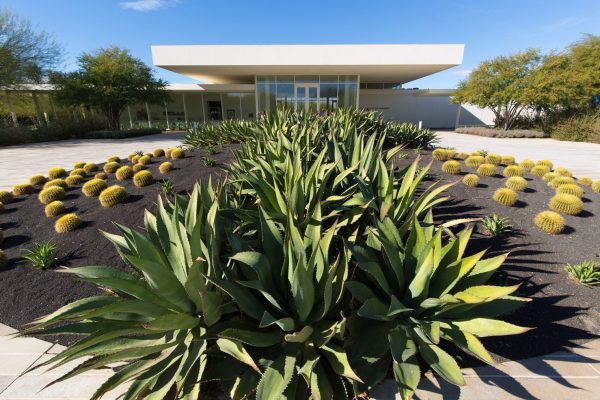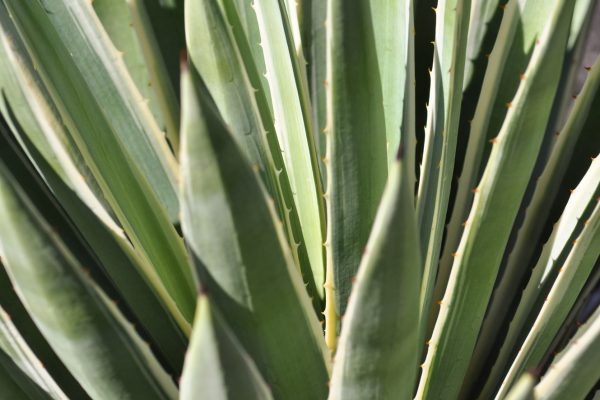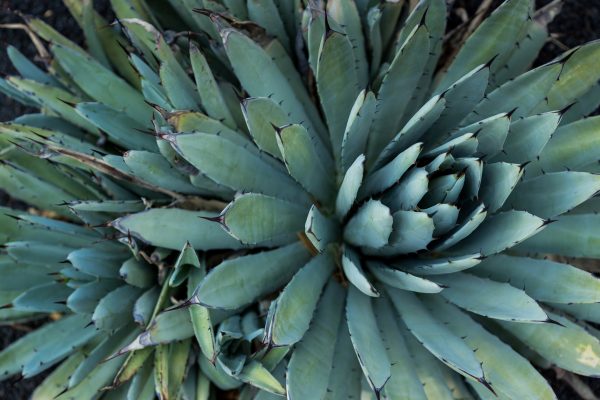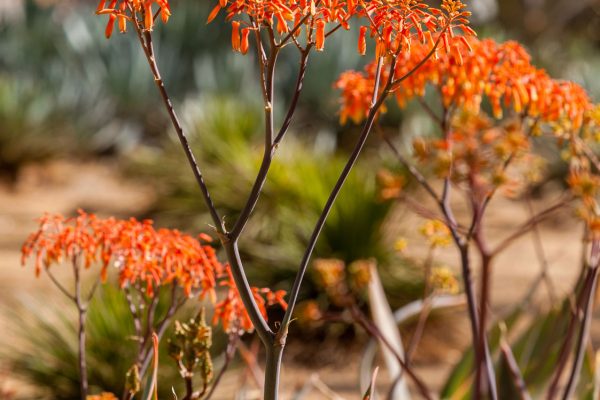
Coral Aloe is in the shaded garden beds outside of the path that surrounds the Great Lawn. Its appearance is an interesting contrast to the more formal structure of the Medicinal Aloe. Its wide and flat leaves are greenish-blue with a light pink margin (edge), but unlike the upward reaching leaves of the Medicinal Aloe, its relaxed leaves appear to flop open as it bathes in the dappled light under the Palo Verde trees.
Like other aloes, it blooms annually starting in January and continues through spring. The flower stalk differs from Medicinal Aloe and Blue Elf. Where they grow a single stalk in the shape of a bayonet, this multi-branching species has blooms that spread wide, like a tree canopy. The flowers are bright red-orange with a creamy-white tip. After the bloom, it sets seedpods that resemble green grapes. Like some other succulents, Coral Aloe will form clones or pups around the base, which can be collected and replanted.
The origin of Coral Aloe is the Cape Provinces of Africa, where it prefers the driest areas and elevations ranges of 800 to 7,300 feet.

Blue Elf is a small but mighty succulent that can withstand the sun’s full attention on the hot desert floor. The smallest of the aloes at Sunnylands, its clumping nature allows it to spread readily to 2 feet. Visitors will first experience Blue Elf when walking to the front of the Center. It’s found growing in four beds below the Sweet Acacia trees that frame the entrance and anchor the entry circle. It is also on the west side of the gardens where it replaced the less successful Angelita Daisy (Tetraneuris acaulis) from the original 2012 landscape plan. It has proven to be a true powerhouse in the gardens.
The leaves of the aloe sometimes display a pink blush. This is the result of a protection mechanism that helps prevent plant cell sun damage. This response is linked to the storage of the pigment rhodoxanthin in the cells of aloes and can be triggered by environmental stressors, such as low water, but it’s usually seen on plants in full sunlight, which is the other environmental trigger. Planting in shade can reduce the blush, but too much shade may also inhibit its blooms.
Blooming begins annually in January and continues in mass through spring, but other times of the year a single aloe may send up a rogue flower stalk catching visitors’ full attention. Its flower stalk will top out at only 18 inches, displaying red-orange tubular flowers that are the delight of hummingbirds. This easy to grow plant has proven to be most popular with the dozens of Costa’s and Anna’s Hummingbirds that inhabit the gardens.
Reported in North Africa in the Canary and Cape Verde Islands.
Another species that may not be immediately recognizable as an agave is the A. geminiflora. Having attributes including filaments along its margin, instead of teeth, may cause it to be confused with Hesperaloe, which has this similar feature. The leaves are very narrow and flexible. As it grows, a stem will begin to form below its rosette of 200 densely placed, and curved leaves.
The name Twin-flowered or geminiflora describes its paired flower display. Its blooms are yellow with a red flush that grow at the top of a spike that can rise up to 12 feet. This bloom will happen once at end of life. Offsets and bulbils are rare, so propagation is mostly by seed.
Its origin is the Mexican state of Nayarit, with its range at elevations between 3,000 to 4,000 feet. Very susceptible to cold, it needs protection from frost, even in the low desert, but in general can tolerate some shade.

In two specimen beds at the south side of the Center, there are a few small, very decorative Thorn-crested Agave. Normally this variety grows to a maximum of about 2 feet, but there are many hybrids of various sizes and colors. The variety at Sunnylands is ‘quadricolor,’ meaning its leaves display four colors. There are three distinct shades of green striping on the leaves that are framed with red teeth along the margins.
When planted in full sun, you will see a pink blush. This is a process which is visible in other desert species as well. You may notice it particularly on succulents. As part of the photosynthesis process, green chlorophyll in plants is the mechanism that captures light and converts it to food, but too much sunlight can also damage cells. Turning off some of those light receptors can protect plants. This pink blush is one photo-protective mechanism that reduces the plant cell damage from sun exposure. In the case of agaves, it has been attributed to the presence of Anthocyanins (flavonoid pigments) within the plant’s tissue. The exact process and triggers are still being explored. For aloes, the mechanism is due to the presence of rhodoxanthin (see Medicinal Aloe).
A native of the United States and Mexico, Thorn-crested Agave is found in the wild at elevation ranges between 100 and 5,000 feet.
At maturity, it sends up a 12-foot spike that forms yellow-green blooms. As an agave, it will bloom once at end of life. However, during its lifespan it will have also produced offsets, which are clones of itself, often referred to as pups. So in addition to propagation from flowering, the clones can be replanted as well. This species has not yet bloomed at Sunnylands.
Some Smooth Agave began blooming within a season of their planting. In order to ensure that the Center & Gardens would look established on opening day in 2012, some more mature specimens were used. For the agaves, this meant they would be closer to blooming. The first specimen began to bloom in 2013 and additional ones have continued blooming each year since. This has offered visitors the opportunity to see blooms each season, which is great for the experience but results in the necessity of replacement of individual plants.
The Smooth Agave sends up a thick, branching stalk that blooms bright yellow and then forms bulbils (small, fully formed plants), which can be replanted. Smooth Agave does not exist in the wild but is common in cultivation and its offsets form early, so replanting is not difficult.
It has been found to be cold sensitive and die off of lower leaves immediately after a frost is possible.
Not just a fun name, Sharkskin, with its thick, triangular leaves, is a visually appealing, and sturdy agave. Its name comes from the textural feel of its skin that resembles the feel of shark skin. Described as “stout” or “muscular” due the thickness of its leaf base, it maxes out at 3 feet in height. To some it may look like just another agave, but to those who look for slight variations among varieties, it is distinctive.
Sharkskin is pest resistant. It has proven to be a low maintenance selection at Sunnylands, and due to its lack of a finicky nature, so it does well throughout the gardens.
Its origin is Mexico as a hybrid of A. ferdinandi-regis form of A. victoriae-reginae.

This is the description for Parry’s Agave, but there is also an Agave parryi var. ‘truncata.’ For this variety, please see Artichoke Agave.
The Parry’s Agave is a small, neatly designed variety with elliptical leaves arranged in a tight rosette. It is one of the more common agaves in the garden. It can colonize forming offsets around its base. So, in addition to seed collection, these clones can be collected, and at Sunnylands they are harvested for future specimen replacements. It is a perfect companion for wildflowers and perennials in desert gardens, but is equally successful in groupings of several Parry’s Agave. It is one of the most cultivated species for low-desert gardens.
Parry’s Agave grows an inflorescence (flowering stem) that may rise up to 20 feet, extending branches that will hold bright yellow flowers, touched with red or pink.
It’s origins include Arizona, New Mexico, and the Mexican states of Chihuahua and Durango at an elevation range between 1,500 and 8,000 feet, but it has done equally well on the desert floor. The vast range of this species allows it to thrive in many locations.
Murphy’s Agave was not included in the original design plan in 2012. It was brought in later as a test to replace the more frost-tender Smooth Agave in some of the shaded garden beds. Due to high temperatures in the Coachella Valley, it does well in these shaded sections, but in colder areas it will require full sun. At Sunnylands, you can find it north of the Center under Palo Brea trees. It shares the urn-like shape of the Smooth Agave, but having fewer offsets than the Smooth Agave it needs less maintenance to keep its urn-shape visible.
Its stalk can grow to 13 feet, displaying bright yellow blooms tipped with purple. It rarely sets seeds but does set bulbils after it blooms. These can be collected and replanted.
Murphy’s Agave is native to the rocky slopes of central Arizona at elevation ranges between 1,500 and 3,000 feet.
The Desert Agave is a medium-sized agave with upright, rigid leaves ending in a strong terminal spine at its tip. It can be found in the lower gardens south of the entry drive, or to the right of the drive if you are standing with your back to the Center.
A local desert native, it is planted throughout the gardens as part of the original landscape design. Gradually rising temperatures in the desert, along with a reduction of winter chills lasting long enough to keep pests at bay, resulted in the struggle of some plants in the first few years. After becoming established, the current Desert Agave specimens are doing well, with some having completed their bloom.
The inflorescence (flowering stalk) can reach up to 13 feet with bright yellow blooms, but this occurs at end of life usually between 15 and 20 years of age, and the plant will die shortly thereafter, leaving the next cross-pollinated generation to move forward.

In front of the Center, in the middle of the motor court, is a medallion-shaped bed where specimens of Cowhorn Agave are arranged among Golden Barrel cactus in a black scoria (lava stone) mulch. The margins of the Cowhorn’s leaves display reddish-brown teeth in a dimorphic (two-style) growth pattern. The teeth are both straight and curved, which results in a “snaggle-toothed” appearance. This is a contrast to some other agaves, which have a somewhat more uniform margin. Cowhorn is also found along the entry drive near the Bob Hope gate, but safe, close-up viewing is best done at the motor court.
This native of Mexico grows wild within an elevation range of 3,000 to 6,000 feet. Cowhorn Agave has not yet bloomed at Sunnylands. It will bloom only once, at end of life—usually between 12 to 18 years. The spike can reach over 20 feet, displaying greenish-yellow flowers.
This species does very well on the desert floor. Though it is more likely to be harmed by frost, it can be light sensitive during high-summer heat.

The variety of Caribbean Agave at Sunnylands is ‘marginata,’ and its name refers to the striped margins of its leaf edge. It is in the specimen beds closest to the solar field. Late in life, it will begin to grow a stem that raises a rosette of leaves off the ground. Often this happens right before the plant blooms.
When it does bloom, this final act will require all of the energy it has been storing during its life. It will send up a 16-foot branched stalk that will bloom and then set bulbils (small, fully formed plants). These can be collected and propagated. If left alone, they will tumble down to root around the parent or blow off to bloom elsewhere and begin a new colony. Earlier during its life, it will also have grown offsets or clones that can replanted. In the wild, it may form a colony of these cloned versions of the parent plant. It is possible that the parent plant will be long gone from older colonies.
This is a native of northern Mexico, but it has an extensive range with varieties as far south as Costa Rica.

This geometric wonder plant grows in complete contrast to the urn-like or the tight rosette structure of some other agave. It’s identifiable by its rigid, straight, and linear leaves that radiate from its heart, like a starburst. This stand-out agave is easiest to find in beds to the south of the Great Lawn. The black-spined leaf margins give it its common name. Everything about its perfectly balanced structure evokes symmetry, but with energy.
Though it has not bloomed at Sunnylands, it will—like other agave—bloom once at end of life. A 6-foot branching stalk will produce green flowers with a slight tinge of purple. It will set multiple bulbils, which are small, fully formed plants that will grow on the branching stalk. These will tumble to the ground to root and grow as a new plant. Black-spined Agave can be propagated by seeds, bulbils, or clones, which can be removed and planted.
A native of Mexico, but restricted to the state of Oaxaca and the city of Tehuacán in the Mexican state of Puebla.

